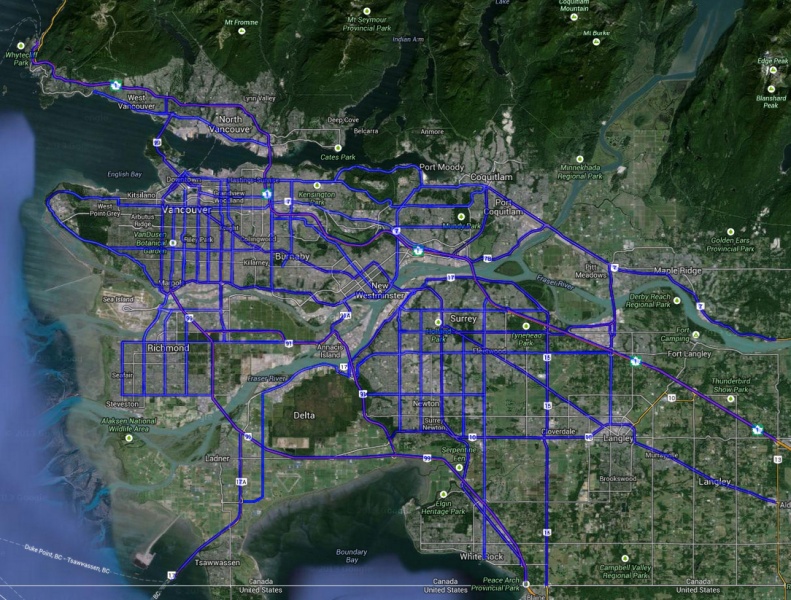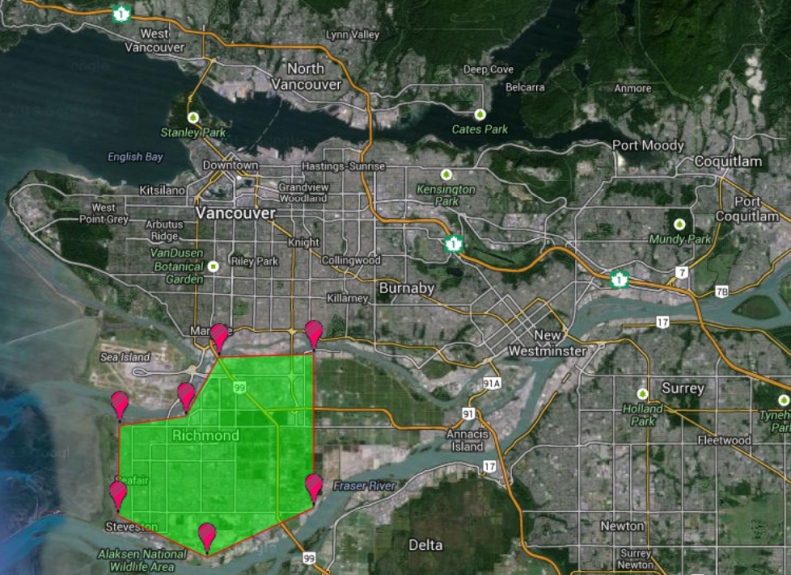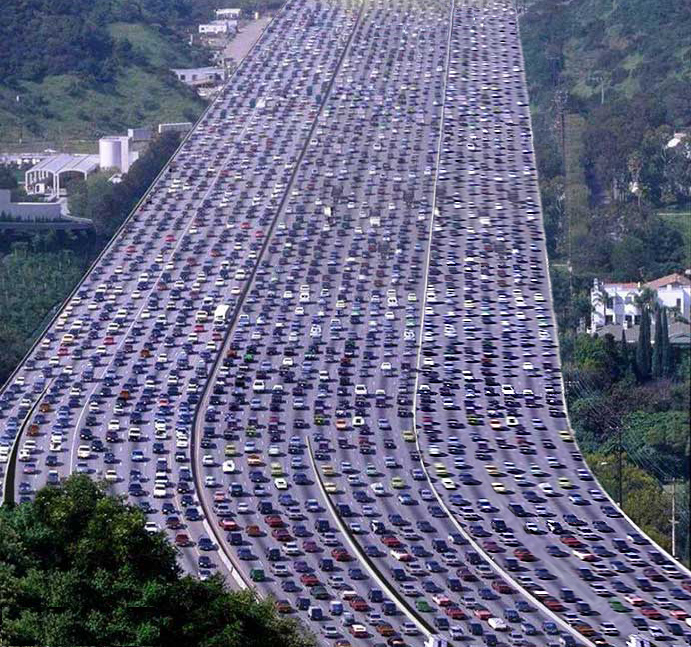*Post updated Feb 17, 2015 with responses to criticisms
RESPONSE TO CRITICISMS
“This is complete hyperbole and not very constructive to the question at hand. All of these fear driven points are doubly true for the current number of vehicles in Vancouver. I just looked out at highway 1 and I don’t see a lineup of cars that stretches to StMarie. If there are 2x as many cars right now how come all of those roads aren’t a parking lot at this very moment? Oh rght, because not everyone is on the road right now.”
Nowhere in the video do I claim that all of the vehicles will occupy the road at once. So yes we do have enough vehicles to stretch from here to Sault Ste Marie twice over, you don’t see that because not everyone is on the roads at once and not everyone is on Highway 1 at once, as you said. All I showed is how much road space the additional vehicles would occupy. It is a way to visualize the number of vehicles.
The important thing to consider is that congestion is not a linear problem. Roads can handle additional traffic up to a point after which the capacity quickly and significantly decreases. Congestion is already a major problem in the region and a 50% increase in traffic will cause a far greater than 50% increase in travel time delays due to the non-linear response.
“and assuming 3 parking spaces per vehicle seems strange. Do we currently have 3 parking spaces per vehicle? Are there literally 132 km2 for parking since you’re basing this on growth then you’re assuming that current trends hold. Obviously no.”
I do claim that 66km2 of parking will need to be constructed, mostly as underground parking. To defend that we can look at the existing parking in Metro Vancouver. In this article http://daily.sightline.org/2013/08/08/park-place/ Chris Quigly, a senior planner at Translink finds or estimates the following: 1 million off-street non-residential parking spaces (as per a 2005 inventory taken), 1.3 million off-street residential spaces (estimate based on number of residential units), and 1 million on-street curb spaces (estimate based on spaces per linear foot adjusted by a number of factors).
This results in 2.2 parking spaces per 2013 vehicle. As it states in the article this is likely a conservative estimate. The majority of parking studies turn up a higher ratio, including the two I originally used as sources. At 30m2 per off street parking space and 15m2 per on street parking space gives 84 km2 of parking in the entire region.
As I stated before, One of the reasons that I left the ratio higher than I might have otherwise is that much of the redevelopment that occurs takes place on sites with existing parking (think brentwood, oakridge, etc.) So in order to increase the total parking supply you have to both create new parking underground and recreate the existing parking underground.
“Then you take every “worst case” assumption, and then you in a ridiculous fashion make “best case” for the reverse. OH MY GOD! JUST for the growth we’d need a 26 lane freeway! Obviously to compliment our current 52 lane freeway for our current system and load. Remember, we’re talking about a 50% increase so clearly if your logic is anywhere near correct you should see these already right?”
Keep in mind that there are currently 50 vehicle lanes to the Burrard Peninsula, along with the Expo line, Canada line, west coast express, sea bus, and bus routes. But the last claim I explicitly make in the video is that you took the expo lines ultimate hourly capacity (from the SNC-Lavalin report I link to on my site), and put them in their own vehicles, it would take 26 freeway lanes to be able to move the same number of people. You said my claim was hyperbole because if need a 26-lane freeway to move the new vehicles then that would mean we need a 52-lane freeway to move the existing residents and we don’t have one. Your response is to an entirely different claim than I actually made.
“These numbers are reasonable… you know because all 750,000 new cars are going to be driven 24 hours a day all while each occupying 3 different parking spots at the same time.”
Off-street parking doesn’t behave like a game of musical chairs. I have a parking space at home that nobody occupies when I am gone, and I have a parking space at work that nobody occupies when I am gone. So that’s 2 parking spaces for one vehicle, without looking at anything other than home and work. The fact that most spaces are vacant most of the time means that there must be many more parking spaces than vehicles, since cars spend 95% of their time parked.
I am not pulling the number 3 out of nowhere, many people study this issue and 3 is typically considered a conservative estimate. I have provided sources and Google can provide many more that will tell you something similar.
But lets say there was somehow just 1 parking space for each of these vehicles. That is still an extremely large amount of money that has gone toward constructing what will have to be underground parking in the majority of cases.
I’m not sure what you mean by the cars being driven 24 hours all day either. The issue is that a large proportion of the vehicles all have to use the road space within the AM peak period and again in the PM peak period. The required road space to accommodate the peak traffic flows doesn’t vanish when the vehicles are not on it and neither do the required parking spaces.
“$3 billion/year on parking stalls? The city of Vancouver issued $1.12 billion in building permits during the first half of 2014. Assume the metro figure for the entire year will be $6 to $7 billion. There’s no way that ~50% of that would be just for parking stalls! It would be saying that parking stalls cost as much as condo units to construct and that no other construction happens in the Vancouver area. Also, taxpayers don’t pay to build condo owners underground parking spots. Or at where they work or shop for that matter. This point is totally ridiculous.”
From the Altus construction cost guide “The values calculated by building types that usually have underground parking (condominiums, offices and hotels) allow for an underground parking component of 30%”
http://www.altusgroup.com/media/43666/CostGuide_2011_web.pdf
As in example, if you wanted to purchase a 1-bedroom condo in Surrey it would have to include 1.5 parking spaces.
http://www.surrey.ca/bylawsandcouncillibrary/BYL_Zoning_12000.pdf p. 97.
If the site requires underground parking, according to Surrey’s transportation planning department a space will cost around $40,000 to construct. So with the purchase of your unit you are require to buy underground parking that cost $60,000 to construct and will add even more than that to the price of your unit when you add in soft costs and profit margins.
One thing that will be common as we go forward is construction on existing parking lots (think Brentwood, Oakridge, etc. ). On these sites to increase the total parking supply you have to both create new underground parking and recreate the existing parking underground.
I’m sure we could have a good discussion of whether the number would be closer to $90 billion or $60 billion as your thought process would indicate. But I don’t think that is what you are interested in. That is money taken out of the economy that is not available to be put towards other things (such as transit), whether it is private individuals, taxpayers, or business owners who are paying for it.
NOTES AND REFERENCES
1. Population Growth:
Greater Vancouver Regional District Board (2013). Metro Vancouver 2040: Shaping Our Future. p. 68.
2. Vehicle Ownership:
ICBC (2013). Total Number of Registered Vehicles 1999-2013.
3. Vehicle Length:
One of the sources I looked at was a study of the average vehicle lengths in Calgary. In all, 3,225 vehicles models, comprising of 785 Cars, 1068 SUVs, 74 Minivans and 1298 Pick-up Trucks were analyzed. The average length was 5.02m. To come up with what I think would be a conservative approximation for Metro Vancouver if you use an average pickup truck length of 5.6m then the average length of the remaining vehicles is 4.63m. (This should be conservative since there are still plenty of pickup trucks in Metro Vancouver).
Click to access ParkingDimensions_eng.pdf
The additional length to get to 5m comes from the fact that it wont just be personal vehicles that are added but also large commercial vehicles for goods movement. Looking at the proportion of the registered vehicles in Canada that are commercial trucks, buses, and motorcycles and factoring these into the average length estimate increases it by approximately 0.4m.
http://www.statcan.gc.ca/tables-tableaux/sum-som/l01/cst01/trade14a-eng.htm
Another source I did a quick approximation from was the table contained in this story which leads to approximately 4.83m average for the 2007s if you assume an equal number of vehicles in each category.
http://usatoday30.usatoday.com/money/autos/2007-07-15-little-big-cars_n.htm
4. Parking Spaces per vehicle:
“The eminent land-use planner Victor Gruen estimated that every car has at least one parking space at home and three of four waiting elsewhere to serve the car. To be conservative, suppose there is one parking space per car at home and only two elsewhere (at work, school, supermarkets, and so on), or only three parking spaces per vehicle” – Shoup, D. (2005). The High Cost of Free Parking (p. 205).
“Erik Veroheff (1996,97) reports that in the Netherlands there are 3 parking spaces available for every car” – Shoup, D. (2005). The High Cost of Free Parking (p. 220).
5. Area per off-street parking space
“The average of 330 square feet per parking space includes the aisles needed for for circulation within the parking lot” – Shoup, D. (2005). The High Cost of Free Parking (p. 221).
6. Cost per underground parking space:
Smith, C. (2007, Sept 9). Parking Drives Up Costs. Straight.com
$40,000 given by Surrey’s Manager of Transportation Planning as a rule of thumb estimate used by local developers
7. Expo line capacity:
SNC-Lavalin (2010). Expo Line Upgrade Strategy. p. 22.
8. Freeway Lane Capacity
Highway Speed, Flow and Density
IMAGES FROM VIDEO





Thanks very much for this. The single lane example was truly shocking. The only part of the argument that I found less convincing was that each car needs three parking places. Doesn’t that assume that, for example, the space at the supermarket can only be used by one designated car? In other words, if 50 cars use the same slot during a day, doesn’t that reduce the number of slots required? That said, even one parking place per car would have a major cost and perhaps have harmful effects on the environment.
Parking spaces don’t tend to be very efficient. If there were one parking space per vehicle then whenever you left a space another vehicle would have to be arriving soon and whenever you arrived it would have to be in a space that a vehicle recently left. But it doesn’t work like that except for maybe on-street parking spaces in extremely dense and mixed use areas like Manhattan.
I’ll use my office building as an example. Everybody who drove here left a parking space unoccupied at home, and when they leave here the spaces they used will be unoccupied overnight. So except for the small night cleaning staff each person who drives here must have 2 spaces available to them only taking into account home and work.
While all these people are at work there will be malls, sports facilities, restaurants, etc. with their parking lots mostly empty. They are designed with enough parking to accommodate the expected vehicles at their busiest times during the year. So when you think about the total number of parking spaces you have to add the spaces required for the busiest hour of Christmas eve shopping, with the parking needed for big games at stadiums, with the parking required at all the restaurants on Valentines day, with the church parking required on Sundays, and so on. Yes, many people will occupy the same parking spaces at different times, but when you consider all the different uses that need to accommodate the additional vehicles the amount of parking adds up.
How much parking it all adds up to is a matter of debate. In my references I list two sources. The first is a study of the Netherlands that found there were 3 parking spaces per vehicle. The second is an analysis of the United States that estimated there were 4 – 5 parking spaces per vehicle. I have seen estimates of the typical ratio that range from 2.2 – 8 parking spaces per vehicle.
One of the reasons that I left the ratio higher than I might have otherwise is that much of the redevelopment that occurs takes place on sites with existing parking. This means to increase the total number of spaces you have to both create new parking underground and recreate the existing parking underground. So while I might have convinced myself that somewhat less than 66 square kilometers of additional parking were required, it seemed unlikely to me that less than 66 square kilometers of parking would need to be constructed.
Pingback: The Next 10 Years | Analysis
Pingback: 5 Reasons Drivers Should Vote Yes In The Transit Plebiscite | Analysis
Pingback: Matt Taylor: “Five Reasons Drivers Should Vote Yes In The Transit Plebiscite.” | Price Tags
Pingback: Five Reasons Why You Need to Vote Yes | Move